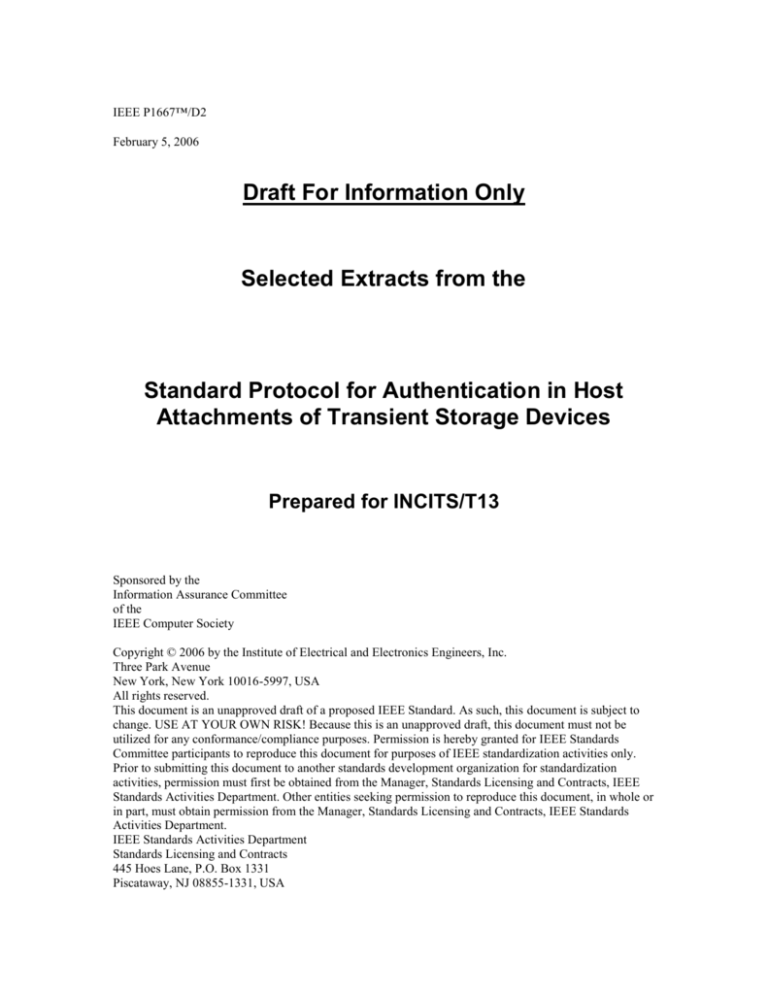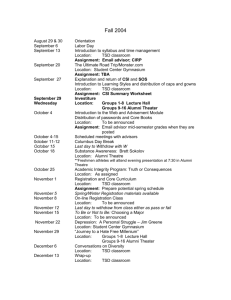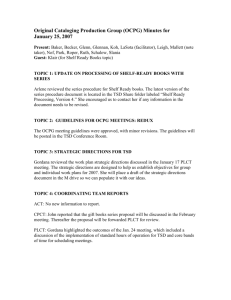
IEEE P1667™/D2
February 5, 2006
Draft For Information Only
Selected Extracts from the
Standard Protocol for Authentication in Host
Attachments of Transient Storage Devices
Prepared for INCITS/T13
Sponsored by the
Information Assurance Committee
of the
IEEE Computer Society
Copyright © 2006 by the Institute of Electrical and Electronics Engineers, Inc.
Three Park Avenue
New York, New York 10016-5997, USA
All rights reserved.
This document is an unapproved draft of a proposed IEEE Standard. As such, this document is subject to
change. USE AT YOUR OWN RISK! Because this is an unapproved draft, this document must not be
utilized for any conformance/compliance purposes. Permission is hereby granted for IEEE Standards
Committee participants to reproduce this document for purposes of IEEE standardization activities only.
Prior to submitting this document to another standards development organization for standardization
activities, permission must first be obtained from the Manager, Standards Licensing and Contracts, IEEE
Standards Activities Department. Other entities seeking permission to reproduce this document, in whole or
in part, must obtain permission from the Manager, Standards Licensing and Contracts, IEEE Standards
Activities Department.
IEEE Standards Activities Department
Standards Licensing and Contracts
445 Hoes Lane, P.O. Box 1331
Piscataway, NJ 08855-1331, USA
1. Overview
1.1 Scope
This project defines a standard protocol for secure authentication and creation of trust between a secure
host and a directly attached Transient Storage Device (TSD), such as a USB flash drive, portable hard
drive, or cellular phone. The protocol has only an indirect relationship with data integrity/security, and does
not directly address issues of authorization and enforcement. The protocol also does not address devices
that are attached using a network connection. However, a device that uses a point-to-point wireless
connection such as WUSB may comply with this protocol.
1.2 Purpose
Industry has witnessed explosive private and corporate growth in use of TSDs. These devices serve much
the same functionality that floppy disks once did, but at much higher capacities and with greater reliability
and functionality. Although floppy disks never required authentication before being read or written by a
host, TSDs have arrived in the marketplace at a time when security has become a much greater issue than
before.
Enterprises are now beginning to require authentication of devices before connection by a host is permitted.
No standard way of accomplishing that authentication exists for these devices. This standard will act to
insure the security of the enterprise using these devices while allowing a continued robust market and a
convenient method of transporting information for the user. The stakeholders are primarily companies that
are chip manufacturers or vendors that incorporate memory chips into memory solutions for mobile and
embedded systems, personal and portable secure data storage, as well as operating system and enterprise
security application vendors.
2. Definitions
For the purposes of this standard, the following terms and definitions apply. [IETF1] should be referenced
for terms not defined in this clause.
1 Authentication: The act of checking the identity or integrity of an entity.
2 Authorization: The process of determining, by evaluating applicable access control information, whether
an authenticated user, device, or host is allowed access to a particular host or device.
3 Command Set: The Command Set is a protocol that facilitates authentication between a host and a TSD.
The Command Set also includes commands that implement security features such as Certificate Store
access, cryptography, and device authentication.
4 Connect: The process of establishing a connection between a host and a device, allowing the use of
functionality in the TSD by the host, or allowing the use of functionality in the host by the TSD, depending
on authorization. Generally, a device is connected to a host via a standard connector such as USB,
FireWire, WUSB, or a dedicated TCP/IP connection. The functionality provided by the TSD and the host
may be limited prior to authentication of the TSD and the host.
5 Consume: To use licensed content in a DRM environment. Consumed content may not be reused outside
of the scope of the DRM environment.
6 Cryptographic Processor: The Cryptographic Processor is a co-processor on the TSD that includes
functionality for cryptographic algorithms. At minimum the Cryptographic Processor must support the
RSA public-key infrastructure algorithms (using the DKP or a user-supplied key) and secure random
number generation. (Algorithms are as defined in [FIPS1].) The Cryptographic Processor is controlled
using the Command Set.
7 Device Key Pair: A DKP is a pair of public and private keys, associated with a TSD. The private key is
stored securely on a TSD and cannot be retrieved by a host using any command. However, it can be
challenged by encrypting data with the public key, which is readily available using the Command Set.
There may be more than one DKP in a TSD.
8 Globally Unique ID: A GUID is an immutable globally unique device serial number. This serial number
is associated with a device at manufacturing time and cannot be changed.
9 Device: see Transient Storage Device
10 Host: A computer, server, or other provider of services to a user that has a client-server relationship
with a TSD in which the user primarily interacts with the host.
11 Mass Storage Class: USB device class for mass storage devices as defined in [USB2].
12 Policy: A policy is a series of rules that defines security for a connection, device, or host. Policies define
access control lists, usage rules, and audit rules.
13 Transient Storage Device: A TSD is a portable device that provides mass storage capabilities to a host,
but is not permanently attached to a specific host. In this specification, the term “device” may refer to a
physical device or a virtual engine. TSDs in the initial specification will not have additional
authentication requirements other than storage authentication.
14 User: A physical human user of a device and/or host. Users can be authenticated. In a corporate
environment, users correspond to network users. In a commercial environment, users are licensees of
specific content, applications, or entities. Typically, a device has a user associated with it.
15 Virtual Engine: A uniquely addressable instance of a 1667 device interface. One or more virtual
engines can exist in a Transient Storage Device – each instance has all of the properties of the device
interface as defined in this specification.
16 Initialize: Return a device to its original manufactured state
2.1 Acronyms
DC
DKP
DRM
GUID
HC
HKP
MSC
ORC
PKI
RNG
TSD
TPM
VE
WUSB
Device Certificate
Device Key Pair
Digital Rights Management
Globally Unique Identifier
Host Certificate
Host Key Pair
Mass Storage Class
Owner Root Certificate
Public Key Infrastructure
Random Number Generator
Transient Storage Device
Trusted Platform Module, as defined in [TCG1]
Virtual Engine
Wireless USB
3. References
[FIPS1], Federal Information Processing Standards Publication 196: Entity Authentication Using Public
Key Cryptography. Available at http://csrc.nist.gov/publications/fips/fips196/fips196.pdf.
[IEEE1] IEEE P1363, Standard Specifications for Public Key Cryptography.
[IEEE2] IEEE P1363a, Addendum to the Standard Specifications for Public Key Cryptography.
[IETF1] IETF RFC 2828, Available from http://www.ietf.org/rfc/rfc2828.txt?number=2828.
[IETF2] IETF RFC 2459, Available from http://www.faqs.org/rfcs/rfc2459.html.
[ISO1] ISO/IEC 9594-8.
[RSA1],
RSA
Security
Public-Key
Cryptography
Standards
ftp://ftp.rsasecurity.com/pub/pkcs/pkcs-11/v2-20/pkcs-11v2-20.pdf.
#11,
Available
at
[TCG1], Trusted Computing Platform Alliance Main Specification, version 1.1b. Published by the Trusted
Computing Group. Available from http://www.trustedcomputinggroup.com.
[USB1], Universal Serial Bus Specification, Version 2.0. Published by the USB Implementers Forum.
Available at http://www.usb.org.
[USB2], Universal Serial Bus Mass Storage Class Specification Overview. Published by the USB
Implementers Forum. Available at http://www.usb.org.
5. Host Requirements
The host may be a PC, server, cell phone, or any other device that can support the host-side requirements of
P1667. The host includes the following components:
—
—
—
—
PKI algorithm
Cryptographic Random Number Generator
Certificate Store
Host Certificate(s)
7. Transient Storage Device Requirements
The device itself includes one or more VEs, as defined in 7.7. Each VE has the following components:
—
—
—
—
—
—
Certificate Store
Globally Unique Identifier
Device Key Pair
Device Certificate(s)
PKI Algorithm
Random Number Generator
8. Command Set
The Command Set is a series of commands that define functionality on the device level for security
functionality. The Command Set includes cryptographic functions, Certificate Store access, and
authentication functionality
8.2 Transport Protocols
This Specification defines a generic set of functional extensions required for all the supported interface
protocols and Commands Sets for authenticating TSDs. The following sections list and describe the various
physical and logical attachment interface types addressed within the scope of this Specification, with
specific adaptation/integration requirements for each type.
8.2.2 ATA Devices
ATA devices include SATA, IDE/ATA, PCI, and some ATA-based memory cards. Unlike SCSI, all ATAbased devices use a common ATA command set. Thus, this chapter will discuss relevant implementation
notes common to all ATA devices.
10. 1667 State Machine
The following states are described:
—
—
—
—
—
—
Enumerated
Initialized
Not Provisioned
Not Authenticated
Authenticated
Administration Mode
11. Probe
The Probe command allows the device and host to exchange capabilities and version information to
determine if 1667 is supported. The Probe may also identify alternative authentication mechanisms.
11.1 Process of Probing
Probing begins with a determination that the device supports the Probe command. This is specific to the
underlying protocol as listed in section 8.2. Protocols that have discovery mechanisms may use them in
place of the Probe command to accomplish the same goal.
The Probe command is required before executing any other commands.
12. Commands
The 1667 Command Set is to be implemented as a flexible and extensible collection. The actual set of
commands and capabilities supported by a certain device/host instance is determined using the Probing
mechanism ( see 11 above) The following is a representative (incomplete) list of commands currently
being specified, included herein as an example:
-
-
Provision
Initialize (Reset to Manufacturing State)
Create Certificate Request (DC)
Admin Authenticate
Host Authentication by Device
Challenge Device
Verify Challenge
Get Certificate from Store
Get Current State
Set Certificate
Get DC Count
Get Certificate Type








